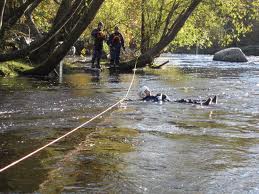Essential skill for many rope-based rescues
A line that crosses the river has many uses:
- A floating tag line (line with a float like a life jacket) provides a safe way to assist someone stuck in a hydraulic like a low head dam.
- A stabilization line can provide support for a trapped boater to help them keep their head out of the water.
- A snag line (weighted in the middle) can be used to safely free someone from a foot entrapment.
- Equipment and people can quickly traverse the creek via a line crossing. Here is a video of a zip line crossing: Zip Line Crossing.
- A variation of this technique is used to safely lower a boat as a platform or a rescuer in a rescue PFD.
This is a great skill to master.
How do you get a line across the river?
If you have ever tried to ferry a line across a fast moving and wide river, you know this can be a real challenge. First off, get a person or two across to form the receiving party. If there is a narrow section reasonably close, you can often toss in the normal manner. Once received, each side simply walks the line upstream to where it is needed. Sometimes you can cheat and wade into the water to an eddy or rock to reduce the throwing distance. Since everyone is supposed to carry a throw rope, have someone toss you another and tie together with an inline figure 8 knot. Sometimes you need to ferry the line via a boat. If available, use a raft or canoe so one person can concentrate on keeping the line out of water. Start high on the shore as well. Thin lines provide far less drag than thick ones. This is a great use for multiple 1/4" lines ties together. Once across, you can simply tie the big rope on the end and quickly pull across. When ferrying a rope, be extremely generous with rope length. If the crossing is 100', tie together 2 or 3 long lines as the boat will most likely drift downstream. Since the line typically drags a boat downstream, plan ahead and start high in the rapid/current and ferry quickly on an angle downstream. People on the other side should be ready to grab the boat or rope ASAP.
Line Ferries and Line Crossings
 In many rescues, you need a safe and fast way to cross fast moving water. Establishing a safety line is often the best way to accomplish this goal. Rescues in difficult drops often require a line across the river/creek for safety. Another use for a line across the river is a snag line for foot entrapment. If the current is fast and the river is wide, getting a line across can sometimes prove to be very challenging. It is usually well worth the effort though because you can easily transport gear and people back and forth relatively safely. The line can also provide enough support for rescue work or assist in keeping a victim's head out of the water buying you a great deal more time.
In many rescues, you need a safe and fast way to cross fast moving water. Establishing a safety line is often the best way to accomplish this goal. Rescues in difficult drops often require a line across the river/creek for safety. Another use for a line across the river is a snag line for foot entrapment. If the current is fast and the river is wide, getting a line across can sometimes prove to be very challenging. It is usually well worth the effort though because you can easily transport gear and people back and forth relatively safely. The line can also provide enough support for rescue work or assist in keeping a victim's head out of the water buying you a great deal more time.
Page 3 of 3
